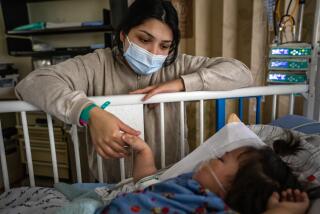1 Kid Treated in ER? Keep Tabs on Rest
- Share via
If you’ve had one child treated recently in a hospital emergency room, keep a very close eye on your other kids. The reason? New evidence suggests that the siblings of children treated for an injury in the ER are also at significantly increased risk of being injured.
The riskiest time for siblings occurs four to 10 days after the first child’s injury, according to Brian D. Johnston, assistant professor of pediatrics at the University of Washington and an investigator at the Harborview Injury Prevention and Research Center in Seattle. But increased risk for injury persists for up to 90 days after the first child is hurt.
Johnston and his colleagues came to those conclusions after reviewing more than 40,000 medical records of children, ages infant to 15 years, enrolled in Medicaid and treated in hospital emergency rooms for unintentional injuries from October 1992 to September 1993. They found that youngsters from families where one child had recently been hurt were up to twice as likely to wind up in the hospital emergency room themselves as those whose siblings had not been injured recently.
The risk of injury peaked in the second week after the first child was hurt and then started to decline. But for more than a month, it remained 50% higher than in families without recent injuries. The risks didn’t return to normal until 90 days after the first injury.
Johnston and his colleagues are trying to figure out why some children have more accidents than others. In a recent issue of the journal Pediatrics, he and his team dismissed the idea that some youngsters are simply accident prone.
“Rather than talking about injury-prone children, it’s probably more useful to ask what was going on in these families,” Johnston said.
In some cases, caring for the injured child may be enough to distract parents from caring for their other children. Or it may be that a stressful event, such as the birth of a child, a recent move or a family death, overtaxes the family and leaves children more vulnerable.
The message for families, Johnston said, is that there are “some periods in life that are riskier than others. Having one child injured is probably a marker for increased vulnerability. It just makes common sense to stop and think about why your first child got injured and what has changed in your environment that could impact injury with your other kids.”






